The Evolution of Elevators: Physical-Human Interface, Digital Interaction, and Megatall Buildings
STEPHEN R. NICHOLS
Otis Elevator Company
For more than 160 years advances in vertical transportation and elevator technology have been key enablers of the increasingly high-rise buildings that define cities around the world. Improvements in elevator safety, robustness, quality, space efficiency, and performance have allowed buildings and cities to grow megatall.1 The design and construction of such buildings and their vertical transportation systems need to be balanced with improvements that reduce passengers’ anxiety while increasing convenience and efficiency.
This article reviews the history of elevators and their technologies. It then examines specific considerations for megatall buildings, such as building traffic, lobbies and layout, and evacuation. The discussion considers the incorporation of new technologies and user-centered design to improve passenger experience.
BRIEF HISTORY OF ELEVATORS
The functional “job to be done” (Christensen 2011) of an elevator is simple: transport passengers and cargo safely and quickly from one altitude to another.
Early Methods
Elevators have been part of human history as far back as the pyramids of ancient Egypt (Gavois 1983), when the construction of large structures required
___________________
1 Megatall buildings are 600 meters or more. For reference, the original 110-floor World Trade Towers in New York were just over 540 meters. The world’s tallest building, Burj Khalifa in Dubai, is 828 meters.
the capacity to raise materials to greater heights than humans could lift without mechanical advantage. The Egyptians, Romans, Babylonians, and others devised increasingly sophisticated rope and pulley systems, capstans, and other hoists for construction purposes—and there is evidence of an elevator hoistway in the Roman Colosseum completed in the year 80.
The first counterweight, used to balance and counteract the effects of gravity, did not appear before 1670, and hoists were not widely applied to industry until 1830 (Goodwin 2001). Elevators were generally not successful because of their unreliability and lack of safety. Fraying rope and other mechanical failures due to wear and excessive weight were common causes of dangerous accidents that made factory owners reluctant to use elevators for cargo. Passenger use was all but unthinkable.
Invention of the Elevator Safety Brake
The use of levers, ropes and pulleys, and other lifting means persisted without many significant improvements until the invention in 1852 of the elevator safety brake by Elisha G. Otis (1811–61). He demonstrated it at the New York World’s Fair (Figure 12) in 1854 (Goodwin 2001), and it was patented in 1861.
Otis’s invention took a simple flat-leaf spring from a cart and applied it to the roof of an elevated hoist such that, in the event of the hoist rope’s failure, the tension in the spring would cause shoes on either end of the spring to engage with notches in the guide rails at either side of the hoist. As dramatically demonstrated at the World’s Fair, when the rope was cut, the safety brake activated and brought the hoist to an abrupt halt with no harm to the cargo or passengers.
The safety brake quickly transformed an unreliable, little-used industrial tool into a viable means of transporting not only cargo but also people. The first-ever safe commercial passenger elevator was installed in 1857 in a Manhattan department store owned by E.V. Haughwout and Co.
With the commercial success of safe passenger elevators, architects and builders started constructing taller buildings. Prime real estate in buildings and cities quickly moved from the first few floors that were conveniently close to the building entry to the top floors and penthouses away from the dust and clamor of the city street.
The breakthrough in elevator safety prompted the evolution toward taller and taller cities and, eventually, today’s megatall buildings.
___________________
2 All figures and images are provided from the Otis Historical Archive: Historical Photographs, Illustrations and Ads; Digital Image Collection.
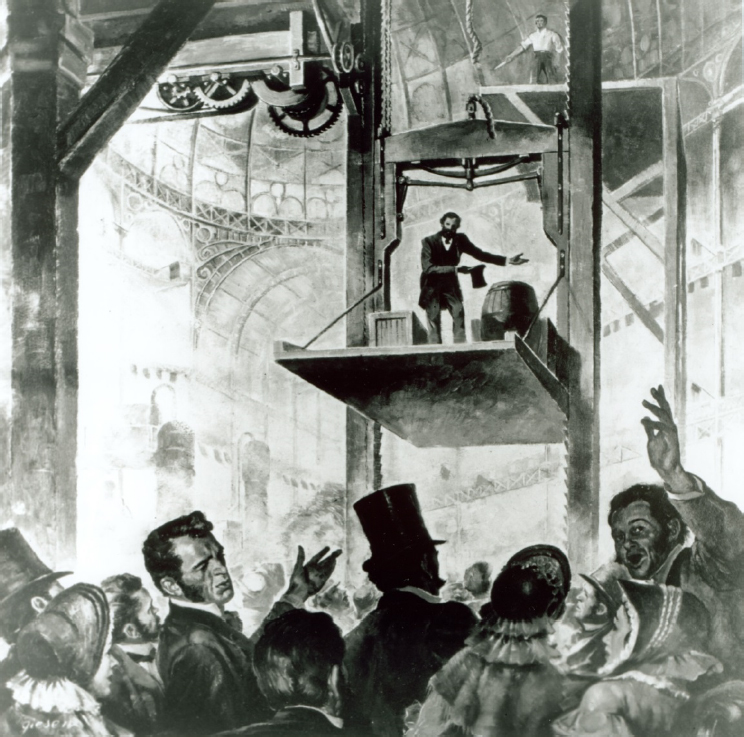
ELEVATOR TECHNOLOGY DRIVERS
The competing benefits and disadvantages of gravity and friction, coupled with continuous improvements in power management, building materials, and other factors, transformed elevators from purely functional devices to a central component of urban buildings and city life.
Harnessing Gravity
The art of elevatoring—moving people vertically through buildings—is fundamentally about controlling gravity, which is both the elevator’s enemy and friend. It must be overcome to move people safely and smoothly, and harnessed (through counterweights and other means) for control and energy savings.
Early advances focused on propulsion technology. Steam engines in the 1850s and 1860s, hydraulic systems in the 1870s, and electric motors in the 1890s (installed at either the top of the elevator hoistway or the bottom of the elevator pit) powered elevators through a variety of arrangements and layouts to enable higher rises, different building configurations, and efficient vertical motion. Rotating machinery and ropes, hydraulic pistons, or the combination thereof created the upward force to pull or push the passenger and cargo compartment up and to stop it safely, smoothly, and accurately at a desired destination.
Improvements in propulsion technology enabled the control of gravity, fostered public confidence in elevators, and led to widespread success. Advertisements initially showed the elevator’s industrial roots with a focus on machinery (Figure 2), but soon luxurious elevator interiors shifted the focus to passengers and elevators became part of the architectural intention of a building.
Controlling Friction
The safe, controlled, smooth deceleration and stopping of an elevator are of paramount importance.
Traction elevators balance friction and the interface between the rope (or belt) and the drive sheave, whether the “rope” is a hemp rope, steel cable, polyurethane-coated steel belt, or carbon-fiber suspension member. Innovations in roping (with one-to-one and two-to-one roping, under- and overslung, and roped hydraulic arrangements) and other technological advances yielded a series of inventions from the latter half of the 19th century into the 20th (see Figures 3, 4). These improvements in elevator machinery and propulsion benefited both passengers and architects as elevators became faster and larger.
Systems in which propulsion did not rely on frictional interfaces were introduced in the 1990s: the first linear motor elevator system was commercially offered by Otis in Japan (Janovský 1999). This system, with the motor mounted on the counterweight, reduces the complexities of controlling friction for propulsion while retaining the counterweight for the advantages of working with gravity. Advances in linear motors will eventually make it possible for multiple elevator cars to travel simultaneously in individual hoistways.
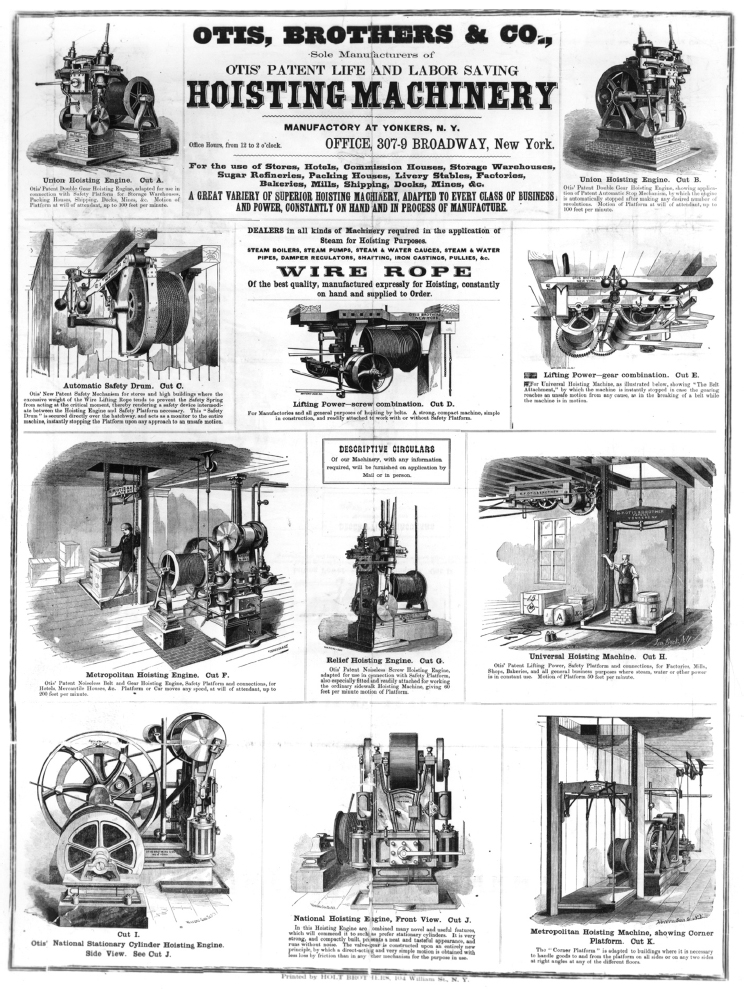
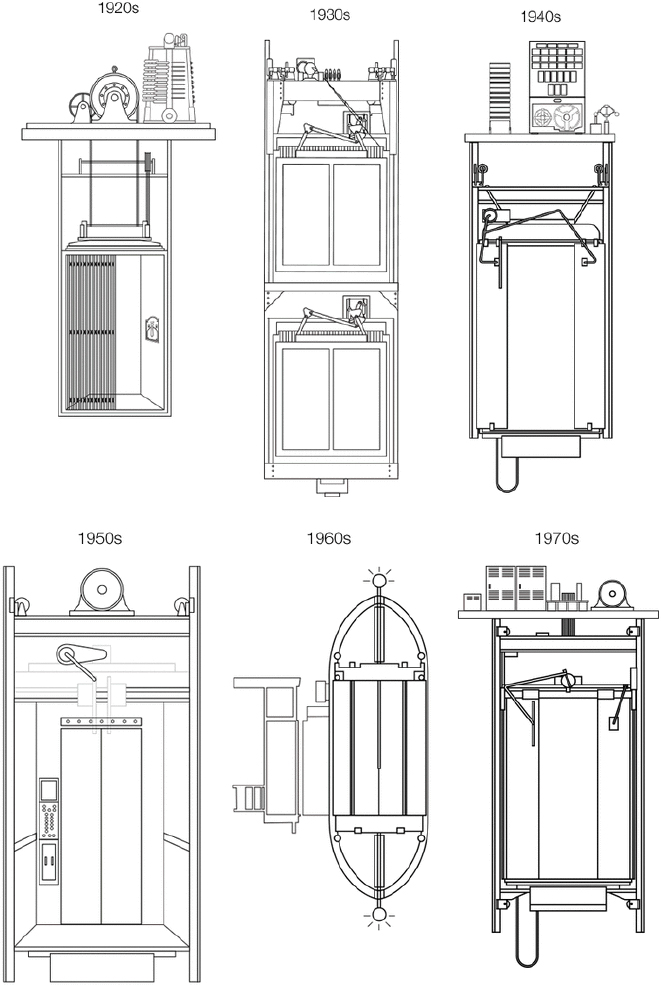
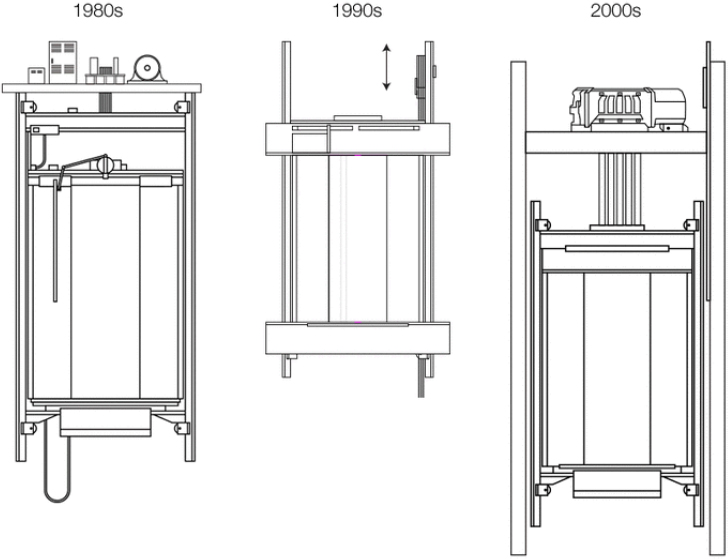
Managing Power
Rotating machinery, whether powered by steam or electricity, and linear motors all require power. Careful management of that power is required for both the elevator system and the building system as a whole.
Innovations like the counterweight and two-to-one roping are advantageous because they require lower power. Reduced power consumption allows propulsion components to be smaller and more efficient, benefiting both the building owner and the architect in the long-term operational cost of the elevator and the building’s overall energy footprint. Linear motors may offer some benefits, but they require significantly higher amounts of power than traditional means (Janovský 1999).
An elevator system’s power use, environmental impact, and sustainability must be considered in the context of the building system and the city itself. Recent
innovations in battery-, solar-, and even hydrogen-powered elevators (Auditeau 2007) are intended to help elevator systems coexist in the environment where they operate.3
Building Construction, Materials, and Use of Core Space
An elevator system must adapt to a building’s construction methods and materials (e.g., concrete, steel, timber). Steel construction in North America may yield different optimal configurations than concrete or prefabricated buildings in Asia. Advances in timber construction for sustainability or seismic advantage will require elevators to innovate along with the building material.
In addition, architects must consider a building’s core space (allocated to elevators, machine and utility rooms, ventilation shafts, and the like) and the percentage of rentable space consumed by an elevator system. Developments such as the ability to use multiple cars in a hoistway can optimize both core space use and traffic flow through a building, as explained below in the discussion of double-deck elevators.
THE PASSENGER EXPERIENCE AND HUMAN BEHAVIOR
Passenger experience is the art and science of matching the elevator experience to the expectations of the people riding the elevator. It is a true human-machine interface that requires enhanced technology, an understanding of human behavior, and the smooth interaction between the two. A user-centered design approach helps to adapt beyond the functional “job to be done” in order to meet new social and emotional requirements.
Personal Expectations
One important dimension of this experience is ride quality. The quality of an elevator ride—the noise and vibration experienced by passengers—is another area where technology has progressed steadily to provide smoother and quieter rides.
Social, circumstantial, and ethnographic differences, however, are associated with different expectations of what constitutes a “good ride.” Residential passengers may think of the elevator as an extension of their living space. Hospitality passengers may want their visit to be better than their home. Commercial passengers may simply expect an efficient and secure journey that does not impinge on their valuable time. Passengers in New York City may want to feel the rush of moving quickly up the building. Passengers in Tokyo may look for the experience
___________________
3 Also see “GeN2 Switch” brochure and information from the Otis Elevator Company (www.otis.com/site/lb/Pages/Gen2-Switch.aspx).
of leaving one space, entering the elevator, and a moment later having the doors open in an entirely new space with little physical feeling of movement.
Technological Enhancements
For much of the early history of elevators, the experience was simple and very personal. Passengers would communicate directly with elevator operators who guided traffic, opened and closed doors, and directed the movement of the elevator car.
Elevator buttons were introduced in 1892, electronic signal control in 1924, automatic doors in 1948, and in 1950 the first operatorless elevator was installed at the Atlantic Refining Building in Dallas. Full automatic control and autotronic supervision and operation followed in 1962, and elevator efficiency has steadily increased in other ways.
Yet questions associated with personal interaction remain. Where is the passenger in relation to the elevator? Is the passenger ready to ride or leave the elevator? Is the passenger allowed to go to his desired destination? How does the machine interact with the passenger to communicate valuable information?
Integration of the Two
Many of the challenges in modern passenger experience involve providing intuitive interactions and behavior solutions, and these can largely be achieved through new technologies and the application of connected and Internet of Things (IoT) technologies from other industries (Gulan et al. 2016). Digital interaction technology such as smartphones, wearables, video analytics, and other sensors, as well as advances in physical-human interfaces (e.g., touchscreens instead of buttons), will greatly improve intuitive behavior.
Technologies can be combined and introduced to lower anxiety and increase convenience and efficiency. Ensuring that passengers feel safe, trust equipment reliability, reduce or eliminate their wait time, get to their destination faster, and travel in a secure, comfortable, personalized space is of paramount importance to elevator technology well beyond the early physics-based problems.
CHALLENGES OF MEGATALL BUILDINGS
The growing height of buildings and the desire for people to live and work at higher altitudes amplify all the challenges discussed.
- Propulsion systems must be devised to carry increasing duty loads of passengers and cargos, yet fairly quickly in high-rise buildings the combined weight of the ropes and suspension components outweighs the desired movable mass.
- Safety and braking technology that works well at low speeds must combat increasingly high forces, thermal loads, and more demanding friction environments.
- Physically moving larger and larger elevator machinery to the top of the building during construction and providing power to those machines throughout the life of the building are monumental challenges for both the elevator and the building itself.
All the challenges in elevator design, from ride quality to seismic concerns, must be considered and optimized, in addition to new, unique challenges such as building sway due to wind. Challenges to the passenger experience (e.g., comfort, convenience, dispatching, traffic flow) also increase dramatically with taller buildings.
Automated Destination Dispatching
Tall buildings and their operators must accommodate the need to efficiently move large numbers of people. With megatall buildings, passengers’ experience must be considered from the moment they enter the building, traverse the lobby, and approach the elevator system.
The potentially competing experiences of seamless elevator use and robust security must be balanced via access control. Effective integration of these aspects is demonstrated at 7 World Trade Center, where the presentation of credentials at lobby turnstiles automatically calls the elevator within milliseconds as passengers walk the 45 meters to board the elevator.
Elevator travel in very tall buildings can be enhanced by faster, smoother rides, but the demands on the propulsion system require that the journey be broken into two or more partial trips. Thus a passenger wishing to go to the 100th floor might board an elevator in the lobby, exit into a “sky lobby” at the 50th floor, and board a different elevator to complete the trip to the 100th floor. One or more of these momentary pauses can delay arrival at the destination floor and increase confusion for the passenger.
Destination dispatching systems were introduced at the turn of the 21st century largely to increase building efficiency and improve traffic flow. They have mathematical advantages over traditional up/down dispatching in taller buildings. Because the passenger enters the final destination (“floor 72”) on the building landing, rather than entering first an “up” call and then “floor 72” in the elevator cab, the dispatching algorithms can intelligently group passengers, route them to the appropriate car, and improve the building’s dispatching efficiency.
In addition, the elevator of the not-too-distant future will be able to automatically recognize individuals, call the elevator, and adapt to where they are going in the building from day to day and hour by hour.
Double-Deck and Multiple Elevators
Megatall building lobbies and their layout must accommodate both the natural flow of people and the desired outcomes of the architects and elevator designers. Double-deck elevators4 appeared in 1931, enabling the transport of significantly more people in a single elevator shaft (Figure 5). Double-deck and super-double-deck elevators (where two cars travel together but can move up to 2 meters independently to accommodate floor height differences) may be used to move larger populations throughout buildings, but they can also be used to segment populations and ferry people to different locations in the building.
The introduction of multiple cars in elevator hoistways provides a dramatic change to the experience of riding an elevator, mandating changes to how elevators communicate with individuals who become more like the passengers of vertical trains.
Evacuation
Evacuation and egress of megatall buildings is of special concern. Historical practice for evacuating any building mandates the use of stairwells for safe evacuation. With increasingly tall buildings and the need to move larger numbers of people, the use of elevators for evacuation is preferable to stairs or refuge spaces. Newer versions of the International Building Code (IBC) provide incentives for using elevators in an occupant evacuation operation for any building over 420 feet tall (128 meters or roughly 38 floors; NEII 2016).
CONCLUSION
The Internet of Things, advances in connectivity, ubiquitous smartphones, and other new digital technologies offer enormous opportunities for interpersonal communication and improvements in myriad dimensions of urban life, including people’s vertical movement in increasingly towering structures for living and working.
Megatall buildings amplify the challenges in all aspects of elevator design for both technology and passenger experience. The goal of vertical transportation systems in megatall buildings should be to provide a natural interaction with the building ecosystem for a safe, efficient, convenient, and personalized passenger experience, balancing advances in elevator and building performance to provide a delightful ride every time.
___________________
4 Two elevator cars attached to the same frame move together, the bottom car serving odd-numbered floors and the upper car even-numbered floors.
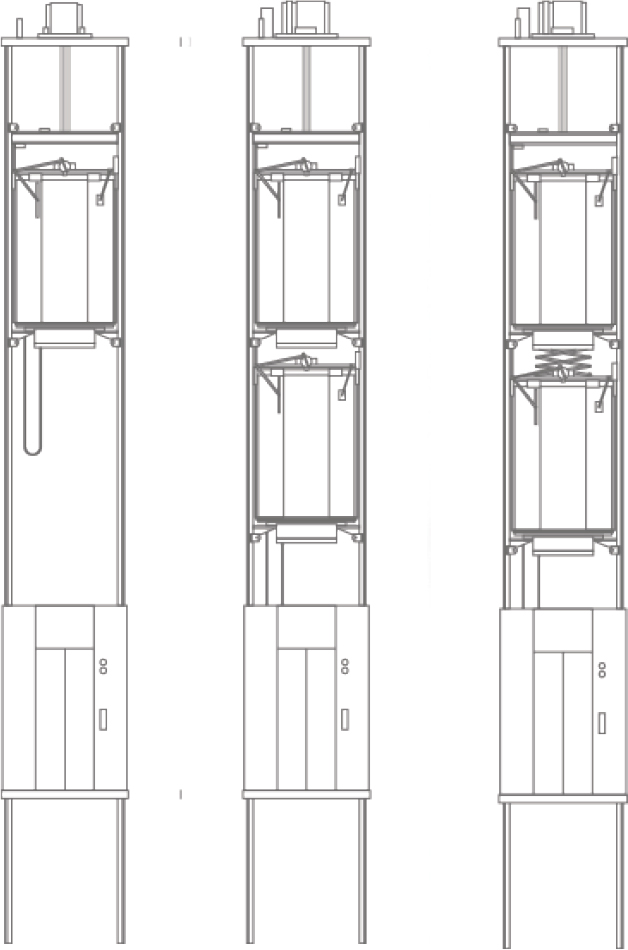
REFERENCES
Auditeau P. 2007. The hydrogen elevator, a world first by Otis in Gien. Synoptos news brief, July 5. http://newsbrief.synoptos.com/fileuploads/L’ascenseur_%C3%A0_hydrog%C3%A8ne_EN.pdf.
Christensen CM. 2011. The Innovator’s Dilemma: The Revolutionary Book That Will Change the Way You Do Business. New York: Harper Business.
Gavois J. 1983. Going Up: An Informal History of the Elevator from the Pyramids to the Present, 1st ed. Farmington CT: Otis Elevator Company.
Goodwin J. 2001. Otis: Giving Rise to the Modern City, 1st ed. Chicago: Ivan R. Dee.
Gulan B, Peterson E, Costabile R, Tang J. 2016. “Informative Design” – Personalized Elevators in the Information Age. Proceedings of the Council of Tall Buildings and Urban Habitat (CTBUH) Conference on Cities to Megacities: Shaping Dense Vertical Urbanism, October 16–21, Hong Kong. http://global.ctbuh.org/resources/papers/download/2991-informative-designpersonalized-elevators-in-the-information-age.pdf.
Janovský L. 1999. Elevator Mechanical Design, 3rd ed. Mobile AL: Elevator World.
NEII [National Elevator Industry, Inc.]. 2016. Occupant Evacuation Operation. The Insider, May 18. http://www.neii.org/insider/editions/20160518.pdf.
This page intentionally left blank.














